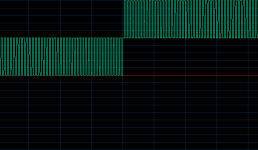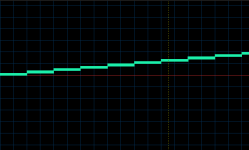Wrong statement. The input signal has no bearing with the "condition" (whatever that means in your foggy language) of the device.
As said the last time, it means that - when measuring with sine or multitone - usually the results only cover the steady state response of the device, but not the transient part of the response.
We already had a very surreal (but funny) discussion about the usual meaning of the term "steady state" back in 2019 and there is no need to repeat it.
...tried to argue this years ago when I first saw it, but people still "believe" or at least go along with the lie.
No such thing as a 32-bit DAC!
Attachments
You would have to point me to a 32bit professional ADC...
Manufacturers seem to describe the bit-depth of a data converter by its internal processing word size, not its analog DNR.
...amplifiers, on the whole, are good enough.
The best amplifiers in terms of SQ tend to be expensive. So expensive only well-to-do people can afford them. The consumers in that market segment expect a nice looking case along with the SQ, and a story about what makes the product special that a lay person could grok. Sorry, but that's way it appears to be.
The best of best amps in that category probably are good enough.
IMHO even for those who prefer the best measurements over the most musical listening experience, Benchmark AHB2 is not cheap either.
Last edited:
Sure. Similar kind of testing to what peufeu was talking about, and that Syn08 gave some IEC standards for. Sometimes it turns up problems that correlate with subjective characteristics of the amp's sound.
Then belief doesn't enter into it.
Belief might matter if someone wants to argue some problem is so small nobody could possibly hear it, that claims of correlation are unproven, blah, blah, and so on. Personally, I believe that some people can hear certain details of sound smaller than published 'limits of audibility' might suggest. Other people might believe differently.
When humans are involved, there are always beliefs.
When humans are involved, there are always beliefs.
Manufacturers seem to describe the bit-depth of a data converter by its internal processing word size, not its analog DNR.
People love to debate, aren't they?
Digital data can be represented by 2 symbols which is 1 and 0. So 3-bit can store 2^3=8 possible values (000, 001, 010, 100, 011, 110, 101, 111).
The more the bits, the more the values that can be stored, the higher the range of the values. If these values are (to store) the converted analog signal amplitudes, the more the bit the higher the possible SNR.
So, if a DAC chip is capable of handling 32-bit data (input). Does the manufacturer have the right to name the chip 32-bit DAC? Why not!?
Since High School, all students are required to show unit of measurements in their calculations for a reason. A 140dB analog SNR has no meaning without knowing the frequency bandwidth and input amplitude.
Manufacturers seem to describe the bit-depth of a data converter by its internal processing word size, not its analog DNR.
Which doesn't make sense ( if i have not lost what you meaned in translation- like Andrea i'm often frustrated by language barrier).
When 32 bit converters become the industry standard then yes it will matter, meanwhile this is the same situation as with 20bits converters with 16bit out. This may sound good ( Studer D19 were 20bit dacs /16bits out and they sounded very good) but it is 24bit stream limited at the source.
What i wanted to say is i think better focus on how to make a good 24bit/96khz dac than the inflation of spec.
The brands i talked about are the reference of top quality for prostudio ( industry) and are priced and speced accordingly. This is what you'll find in the most prestigious place itw.
No 32 bit atm. And 192khz 384khz on some, not more ( and their is good reason for that: clean wordclock become an issue-:the reason why Lavry didn't offer higher than 96khz clocks until their latest model Savitr which is limited at 192khz and this info are not from the internet but a chat with Mr Lavry ( father) himself).
Last edited:
A 32-bit word size can matter in a dac. Its how they get the internal volume control to be high performance. It reduces numerical errors in processing of filters, etc. In other words, its not simply about being able to accept a 32-bit input. One might even argue that 32-bits may not be enough if trying to minimize accumulated numerical errors in, say, a million tap filter. Might depend on whether or not they can find anyone who can reliably hear a difference. If not, then it probably doesn't matter. Chord says they attenuate audio band noise down to -300dB in the digital domain because listening tests show it makes a difference for some people. Of course, they have no idea why. One can choose to believe their story on not. I personally have never tried that experiment, so I withhold forming a belief about it.
So you agree to my point ( already talked about it for treatments - iow dsp- not for the converter side of it).
Is there a point in having 32bit floating point volume control? For consumer maybe.
For my own use i don't see the point as i've made other choice ( compromise one would say) in my gain stagging structure, relative to the fact i still perform some mastering tasks from time to time and have to know if and when the dac distort ( it does have a sound and digital attenuation don't allow for this to pass through). And i use pro line level ( +24dbu) gear in parralel to theamps too...
But i know there must not be many domestic systems calibrated/structured like that, i'm more in line with a mastering room.
Is there a point in having 32bit floating point volume control? For consumer maybe.
For my own use i don't see the point as i've made other choice ( compromise one would say) in my gain stagging structure, relative to the fact i still perform some mastering tasks from time to time and have to know if and when the dac distort ( it does have a sound and digital attenuation don't allow for this to pass through). And i use pro line level ( +24dbu) gear in parralel to theamps too...
But i know there must not be many domestic systems calibrated/structured like that, i'm more in line with a mastering room.
Hi abraxalito,
Yes, we agree I think.
Both technologies are limited by system noise anyway. You need the extra bit depth as soon as you so much as do a level change, never mind EQing the signal or any other process. You really want the digital mix to sound analogue without the low level roughness a shorter digital word can give as the level drops.
Today's equipment is amazing compared to what they were using when I was working in studios. Then it was "good enough" without hiss between the notes.
I listened to the bed tracks off 2" Studer machines, and also the final mix on the master. Then I heard them limit/compress it in the CD mastering suite. Being there for the raw tracks being laid down was interesting too. Mostly what is lost in the recording chain was the impact and dynamic range of the original sounds.
-Chris
Yes, we agree I think.
Both technologies are limited by system noise anyway. You need the extra bit depth as soon as you so much as do a level change, never mind EQing the signal or any other process. You really want the digital mix to sound analogue without the low level roughness a shorter digital word can give as the level drops.
Today's equipment is amazing compared to what they were using when I was working in studios. Then it was "good enough" without hiss between the notes.
I listened to the bed tracks off 2" Studer machines, and also the final mix on the master. Then I heard them limit/compress it in the CD mastering suite. Being there for the raw tracks being laid down was interesting too. Mostly what is lost in the recording chain was the impact and dynamic range of the original sounds.
-Chris
Oh yes.
Here's a nice test signal: what is displayed is the 16 bit sample value, and it flips the LSB for a while, then increments by 1. So this signal is 0 1 0 1 ..... 0 1 2 1 2 1 2 1 ...

Zoom out. This is what bit perfect should look like, SPDIF output of a CD player recorded by a soundcard, resolution is too low to see the LSB flip, but the thickness of the line shows it.

Now, this is what comes out of the SPDIF output of the "legendary" CD723:

It has an undithered volume control, which is buggy: it cannot be set to "multiply by 1" which would be bit perfect. The maximum volume is something like 15/16, which gives a fractional result, which is then simply truncated and not dithered because who cares. So every 16 LSBs, one falls off.
Here's a nice test signal: what is displayed is the 16 bit sample value, and it flips the LSB for a while, then increments by 1. So this signal is 0 1 0 1 ..... 0 1 2 1 2 1 2 1 ...

Zoom out. This is what bit perfect should look like, SPDIF output of a CD player recorded by a soundcard, resolution is too low to see the LSB flip, but the thickness of the line shows it.

Now, this is what comes out of the SPDIF output of the "legendary" CD723:

It has an undithered volume control, which is buggy: it cannot be set to "multiply by 1" which would be bit perfect. The maximum volume is something like 15/16, which gives a fractional result, which is then simply truncated and not dithered because who cares. So every 16 LSBs, one falls off.
A 32-bit word size can matter in a dac.
To be a tad pedantic, 32 bit processing is what matters, whether inside the chip that also contains the dac, or outside, not that the dac is 32bit... I think that's what you meant. Most off the shelf processor cores are at least 32bit or 32bit capable, so I'd be surprised if the SoC dac devices didn't use 32 bit processing.
So, if a DAC chip is capable of handling 32-bit data (input). Does the manufacturer have the right to name the chip 32-bit DAC? Why not!?
Next time you go to a cash machine and type in 100 but only 65 comes out see how you feel about accuracy then.
- Status
- Not open for further replies.
- Home
- Member Areas
- The Lounge
- Sound Quality Vs. Measurements
